snow chains LINCOLN MKZ 2020 Owners Manual
[x] Cancel search | Manufacturer: LINCOLN, Model Year: 2020, Model line: MKZ, Model: LINCOLN MKZ 2020Pages: 561, PDF Size: 5.7 MB
Page 8 of 561
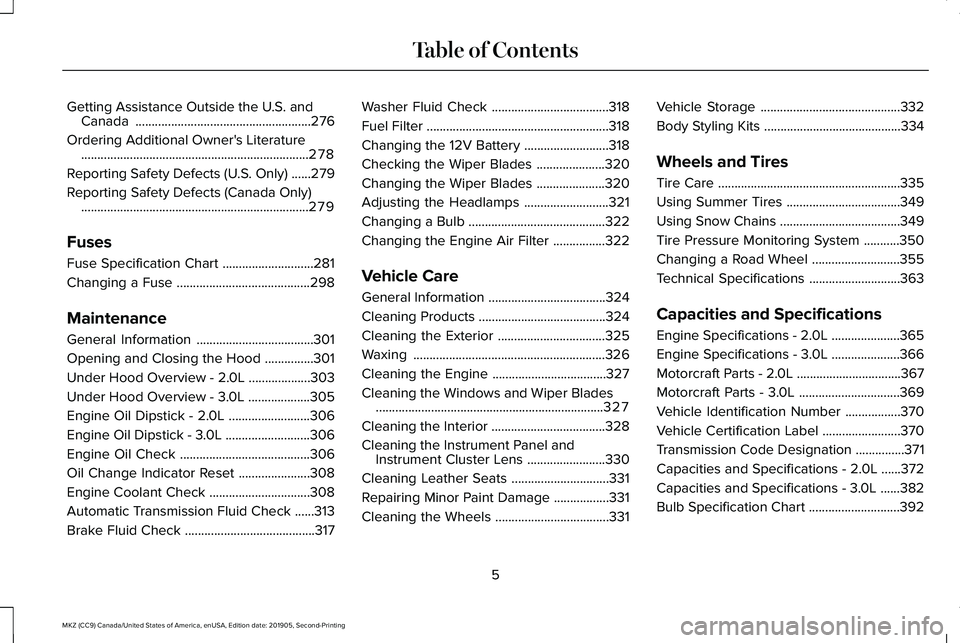
Getting Assistance Outside the U.S. and
Canada ......................................................276
Ordering Additional Owner's Literature ......................................................................
278
Reporting Safety Defects (U.S. Only) ......
279
Reporting Safety Defects (Canada Only) ......................................................................
279
Fuses
Fuse Specification Chart ............................
281
Changing a Fuse .........................................
298
Maintenance
General Information ....................................
301
Opening and Closing the Hood ...............
301
Under Hood Overview - 2.0L ...................
303
Under Hood Overview - 3.0L ...................
305
Engine Oil Dipstick - 2.0L .........................
306
Engine Oil Dipstick - 3.0L ..........................
306
Engine Oil Check ........................................
306
Oil Change Indicator Reset ......................
308
Engine Coolant Check ...............................
308
Automatic Transmission Fluid Check ......
313
Brake Fluid Check ........................................
317Washer Fluid Check
....................................
318
Fuel Filter ........................................................
318
Changing the 12V Battery ..........................
318
Checking the Wiper Blades .....................
320
Changing the Wiper Blades .....................
320
Adjusting the Headlamps ..........................
321
Changing a Bulb ..........................................
322
Changing the Engine Air Filter ................
322
Vehicle Care
General Information ....................................
324
Cleaning Products .......................................
324
Cleaning the Exterior .................................
325
Waxing ...........................................................
326
Cleaning the Engine ...................................
327
Cleaning the Windows and Wiper Blades ......................................................................
327
Cleaning the Interior ...................................
328
Cleaning the Instrument Panel and Instrument Cluster Lens ........................
330
Cleaning Leather Seats ..............................
331
Repairing Minor Paint Damage .................
331
Cleaning the Wheels ...................................
331Vehicle Storage
...........................................
332
Body Styling Kits ..........................................
334
Wheels and Tires
Tire Care ........................................................
335
Using Summer Tires ...................................
349
Using Snow Chains .....................................
349
Tire Pressure Monitoring System ...........
350
Changing a Road Wheel ...........................
355
Technical Specifications ............................
363
Capacities and Specifications
Engine Specifications - 2.0L .....................
365
Engine Specifications - 3.0L .....................
366
Motorcraft Parts - 2.0L ................................
367
Motorcraft Parts - 3.0L ...............................
369
Vehicle Identification Number .................
370
Vehicle Certification Label ........................
370
Transmission Code Designation ...............
371
Capacities and Specifications - 2.0L ......
372
Capacities and Specifications - 3.0L ......
382
Bulb Specification Chart ............................
392
5
MKZ (CC9) Canada/United States of America, enUSA, Edition date: 201905, Second-Printing Table of Contents
Page 193 of 561
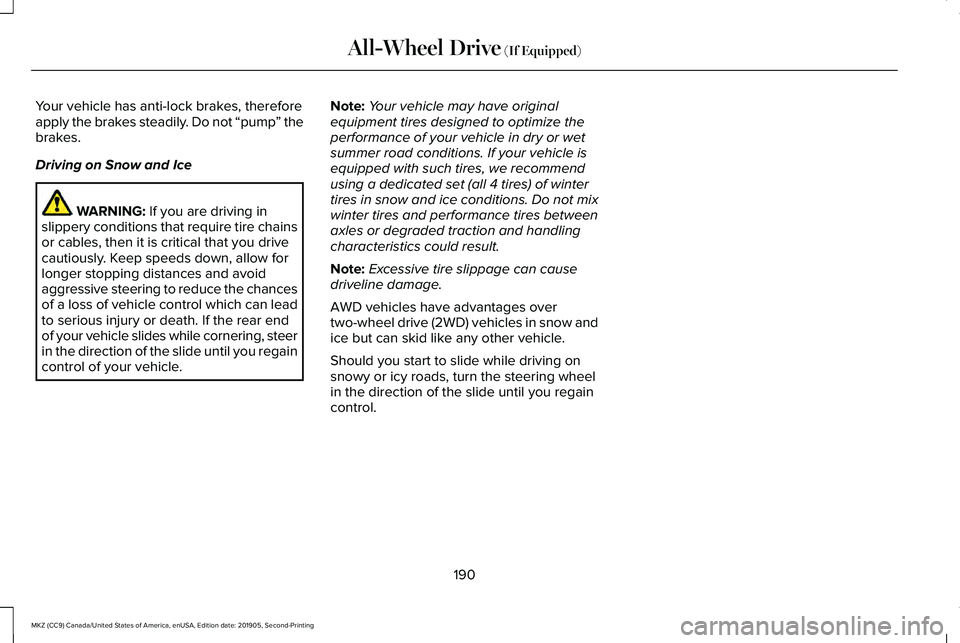
Your vehicle has anti-lock brakes, therefore
apply the brakes steadily. Do not “pump
” the
brakes.
Driving on Snow and Ice WARNING: If you are driving in
slippery conditions that require tire chains
or cables, then it is critical that you drive
cautiously. Keep speeds down, allow for
longer stopping distances and avoid
aggressive steering to reduce the chances
of a loss of vehicle control which can lead
to serious injury or death. If the rear end
of your vehicle slides while cornering, steer
in the direction of the slide until you regain
control of your vehicle. Note:
Your vehicle may have original
equipment tires designed to optimize the
performance of your vehicle in dry or wet
summer road conditions. If your vehicle is
equipped with such tires, we recommend
using a dedicated set (all 4 tires) of winter
tires in snow and ice conditions. Do not mix
winter tires and performance tires between
axles or degraded traction and handling
characteristics could result.
Note: Excessive tire slippage can cause
driveline damage.
AWD vehicles have advantages over
two-wheel drive (2WD) vehicles in snow and
ice but can skid like any other vehicle.
Should you start to slide while driving on
snowy or icy roads, turn the steering wheel
in the direction of the slide until you regain
control.
190
MKZ (CC9) Canada/United States of America, enUSA, Edition date: 201905, Second-Printing All-Wheel Drive
(If Equipped)
Page 352 of 561
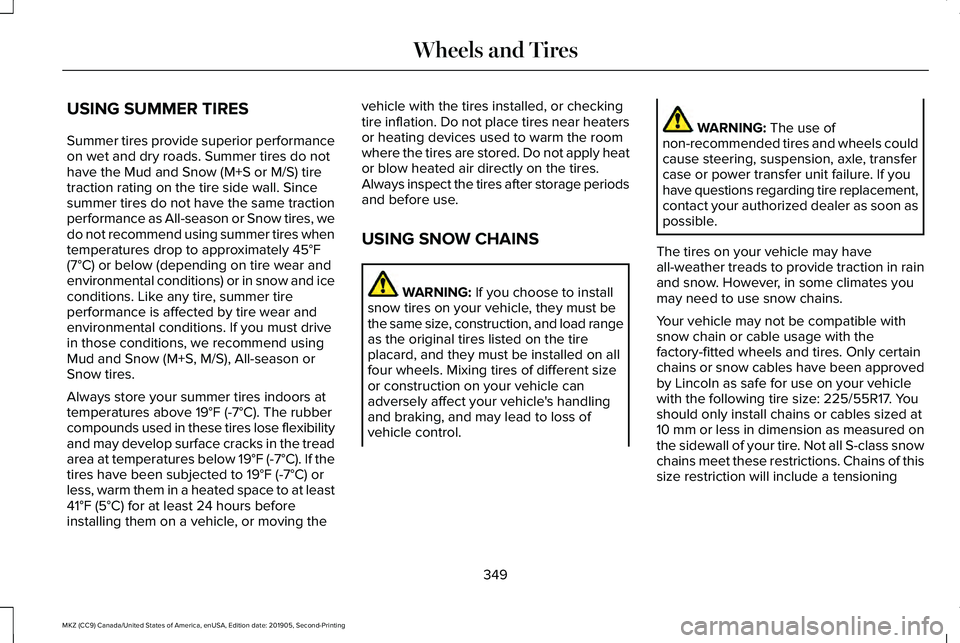
USING SUMMER TIRES
Summer tires provide superior performance
on wet and dry roads. Summer tires do not
have the Mud and Snow (M+S or M/S) tire
traction rating on the tire side wall. Since
summer tires do not have the same traction
performance as All-season or Snow tires, we
do not recommend using summer tires when
temperatures drop to approximately 45°F
(7°C) or below (depending on tire wear and
environmental conditions) or in snow and ice
conditions. Like any tire, summer tire
performance is affected by tire wear and
environmental conditions. If you must drive
in those conditions, we recommend using
Mud and Snow (M+S, M/S), All-season or
Snow tires.
Always store your summer tires indoors at
temperatures above
19°F (-7°C). The rubber
compounds used in these tires lose flexibility
and may develop surface cracks in the tread
area at temperatures below
19°F (-7°C). If the
tires have been subjected to 19°F (-7°C) or
less, warm them in a heated space to at least
41°F (5°C)
for at least 24 hours before
installing them on a vehicle, or moving the vehicle with the tires installed, or checking
tire inflation. Do not place tires near heaters
or heating devices used to warm the room
where the tires are stored. Do not apply heat
or blow heated air directly on the tires.
Always inspect the tires after storage periods
and before use.
USING SNOW CHAINS
WARNING:
If you choose to install
snow tires on your vehicle, they must be
the same size, construction, and load range
as the original tires listed on the tire
placard, and they must be installed on all
four wheels. Mixing tires of different size
or construction on your vehicle can
adversely affect your vehicle's handling
and braking, and may lead to loss of
vehicle control. WARNING:
The use of
non-recommended tires and wheels could
cause steering, suspension, axle, transfer
case or power transfer unit failure. If you
have questions regarding tire replacement,
contact your authorized dealer as soon as
possible.
The tires on your vehicle may have
all-weather treads to provide traction in rain
and snow. However, in some climates you
may need to use snow chains.
Your vehicle may not be compatible with
snow chain or cable usage with the
factory-fitted wheels and tires. Only certain
chains or snow cables have been approved
by Lincoln as safe for use on your vehicle
with the following tire size: 225/55R17. You
should only install chains or cables sized at
10 mm or less in dimension as measured on
the sidewall of your tire. Not all S-class snow
chains meet these restrictions. Chains of this
size restriction will include a tensioning
349
MKZ (CC9) Canada/United States of America, enUSA, Edition date: 201905, Second-Printing Wheels and Tires
Page 353 of 561
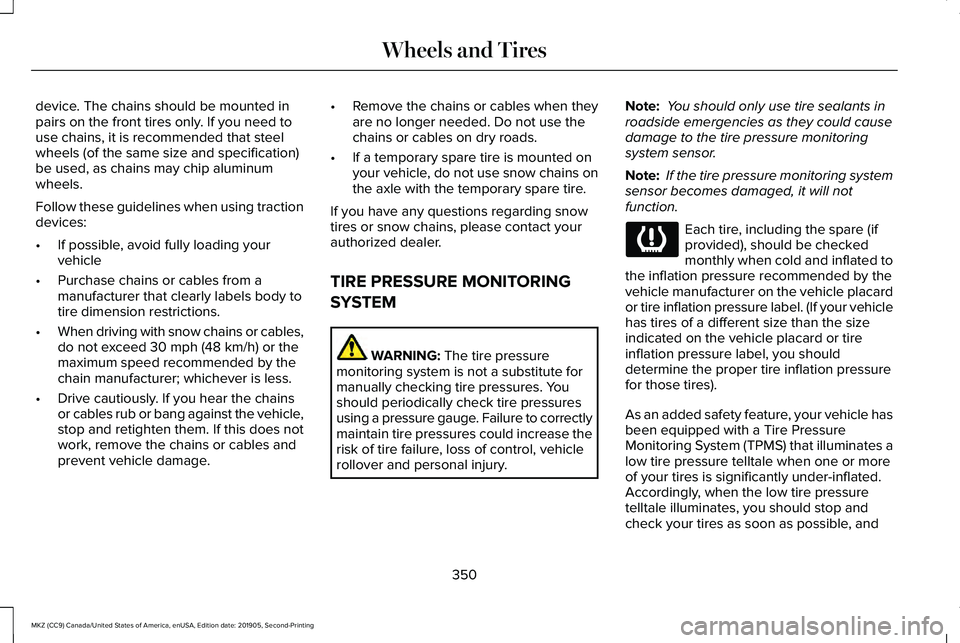
device. The chains should be mounted in
pairs on the front tires only. If you need to
use chains, it is recommended that steel
wheels (of the same size and specification)
be used, as chains may chip aluminum
wheels.
Follow these guidelines when using traction
devices:
•
If possible, avoid fully loading your
vehicle
• Purchase chains or cables from a
manufacturer that clearly labels body to
tire dimension restrictions.
• When driving with snow chains or cables,
do not exceed 30 mph (48 km/h) or the
maximum speed recommended by the
chain manufacturer; whichever is less.
• Drive cautiously. If you hear the chains
or cables rub or bang against the vehicle,
stop and retighten them. If this does not
work, remove the chains or cables and
prevent vehicle damage. •
Remove the chains or cables when they
are no longer needed. Do not use the
chains or cables on dry roads.
• If a temporary spare tire is mounted on
your vehicle, do not use snow chains on
the axle with the temporary spare tire.
If you have any questions regarding snow
tires or snow chains, please contact your
authorized dealer.
TIRE PRESSURE MONITORING
SYSTEM WARNING: The tire pressure
monitoring system is not a substitute for
manually checking tire pressures. You
should periodically check tire pressures
using a pressure gauge. Failure to correctly
maintain tire pressures could increase the
risk of tire failure, loss of control, vehicle
rollover and personal injury. Note:
You should only use tire sealants in
roadside emergencies as they could cause
damage to the tire pressure monitoring
system sensor.
Note: If the tire pressure monitoring system
sensor becomes damaged, it will not
function. Each tire, including the spare (if
provided), should be checked
monthly when cold and inflated to
the inflation pressure recommended by the
vehicle manufacturer on the vehicle placard
or tire inflation pressure label. (If your vehicle
has tires of a different size than the size
indicated on the vehicle placard or tire
inflation pressure label, you should
determine the proper tire inflation pressure
for those tires).
As an added safety feature, your vehicle has
been equipped with a Tire Pressure
Monitoring System (TPMS) that illuminates a
low tire pressure telltale when one or more
of your tires is significantly under-inflated.
Accordingly, when the low tire pressure
telltale illuminates, you should stop and
check your tires as soon as possible, and
350
MKZ (CC9) Canada/United States of America, enUSA, Edition date: 201905, Second-Printing Wheels and Tires
Page 360 of 561
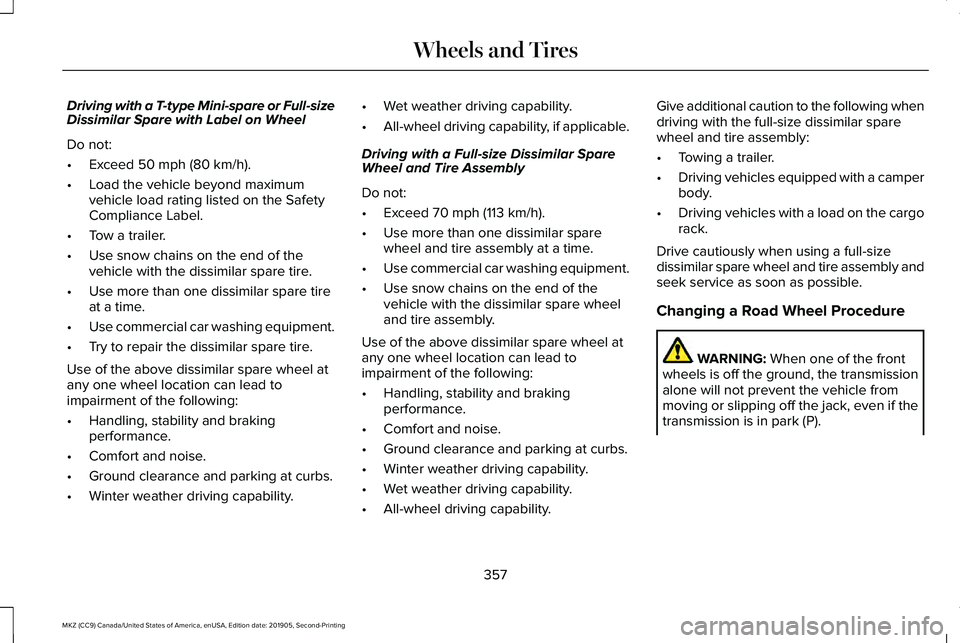
Driving with a T-type Mini-spare or Full-size
Dissimilar Spare with Label on Wheel
Do not:
•
Exceed 50 mph (80 km/h).
• Load the vehicle beyond maximum
vehicle load rating listed on the Safety
Compliance Label.
• Tow a trailer.
• Use snow chains on the end of the
vehicle with the dissimilar spare tire.
• Use more than one dissimilar spare tire
at a time.
• Use commercial car washing equipment.
• Try to repair the dissimilar spare tire.
Use of the above dissimilar spare wheel at
any one wheel location can lead to
impairment of the following:
• Handling, stability and braking
performance.
• Comfort and noise.
• Ground clearance and parking at curbs.
• Winter weather driving capability. •
Wet weather driving capability.
• All-wheel driving capability, if applicable.
Driving with a Full-size Dissimilar Spare
Wheel and Tire Assembly
Do not:
• Exceed
70 mph (113 km/h).
• Use more than one dissimilar spare
wheel and tire assembly at a time.
• Use commercial car washing equipment.
• Use snow chains on the end of the
vehicle with the dissimilar spare wheel
and tire assembly.
Use of the above dissimilar spare wheel at
any one wheel location can lead to
impairment of the following:
• Handling, stability and braking
performance.
• Comfort and noise.
• Ground clearance and parking at curbs.
• Winter weather driving capability.
• Wet weather driving capability.
• All-wheel driving capability. Give additional caution to the following when
driving with the full-size dissimilar spare
wheel and tire assembly:
•
Towing a trailer.
• Driving vehicles equipped with a camper
body.
• Driving vehicles with a load on the cargo
rack.
Drive cautiously when using a full-size
dissimilar spare wheel and tire assembly and
seek service as soon as possible.
Changing a Road Wheel Procedure WARNING:
When one of the front
wheels is off the ground, the transmission
alone will not prevent the vehicle from
moving or slipping off the jack, even if the
transmission is in park (P).
357
MKZ (CC9) Canada/United States of America, enUSA, Edition date: 201905, Second-Printing Wheels and Tires
Page 558 of 561
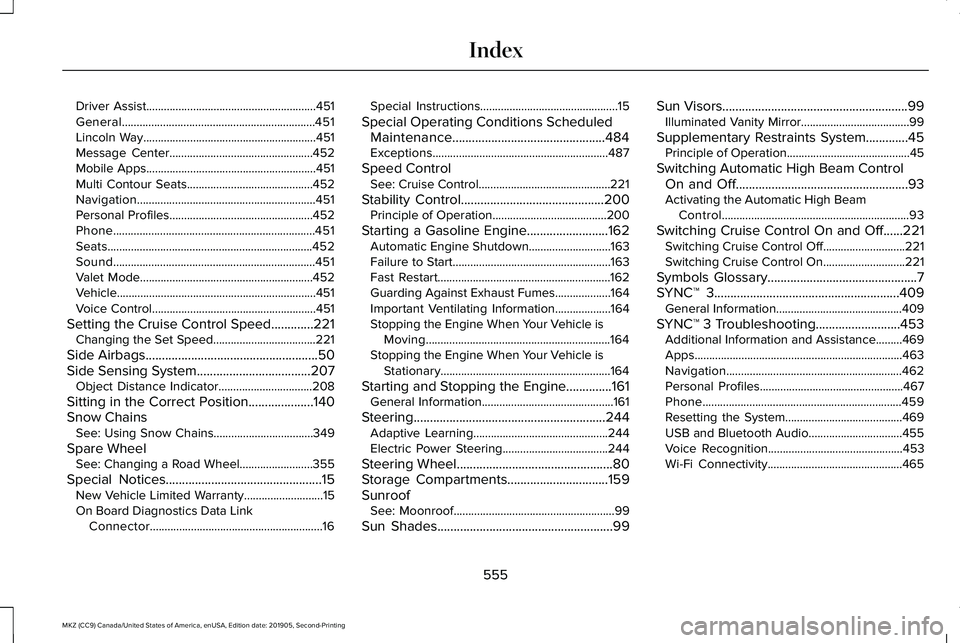
Driver Assist..........................................................451
General..................................................................451
Lincoln Way...........................................................451
Message Center.................................................452
Mobile Apps..........................................................451
Multi Contour Seats...........................................452
Navigation.............................................................451
Personal Profiles.................................................452
Phone.....................................................................451
Seats......................................................................452
Sound.....................................................................451
Valet Mode...........................................................452
Vehicle....................................................................451
Voice Control........................................................451
Setting the Cruise Control Speed.............221 Changing the Set Speed...................................221
Side Airbags.....................................................50
Side Sensing System...................................207 Object Distance Indicator................................
208
Sitting in the Correct Position....................140
Snow Chains See: Using Snow Chains..................................349
Spare Wheel See: Changing a Road Wheel.........................
355
Special Notices
................................................15
New Vehicle Limited Warranty...........................15
On Board Diagnostics Data Link
Connector...........................................................16 Special Instructions...............................................15
Special Operating Conditions Scheduled Maintenance...............................................484
Exceptions............................................................487
Speed Control See: Cruise Control.............................................221
Stability Control
............................................200
Principle of Operation.......................................200
Starting a Gasoline Engine.........................162 Automatic Engine Shutdown............................163
Failure to Start......................................................163
Fast Restart...........................................................162
Guarding Against Exhaust Fumes...................
164
Important Ventilating Information...................164
Stopping the Engine When Your Vehicle is Moving...............................................................164
Stopping the Engine When Your Vehicle is Stationary..........................................................164
Starting and Stopping the Engine..............161 General Information.............................................161
Steering ...........................................................
244
Adaptive Learning..............................................244
Electric Power Steering....................................244
Steering Wheel
................................................80
Storage Compartments...............................159
Sunroof See: Moonroof.......................................................99
Sun Shades
......................................................99 Sun Visors
.........................................................99
Illuminated Vanity Mirror.....................................99
Supplementary Restraints System.............45 Principle of Operation..........................................45
Switching Automatic High Beam Control On and Off.....................................................93
Activating the Automatic High Beam Control................................................................93
Switching Cruise Control On and Off......221 Switching Cruise Control Off............................221
Switching Cruise Control On............................221
Symbols Glossary
..............................................7
SYNC™ 3.........................................................409
General Information...........................................409
SYNC™ 3 Troubleshooting..........................453 Additional Information and Assistance.........469
Apps.......................................................................463
Navigation............................................................462
Personal Profiles.................................................467
Phone....................................................................459
Resetting the System........................................469
USB and Bluetooth Audio................................455
Voice Recognition..............................................453
Wi-Fi Connectivity..............................................465
555
MKZ (CC9) Canada/United States of America, enUSA, Edition date: 201905, Second-Printing Index
Page 559 of 561
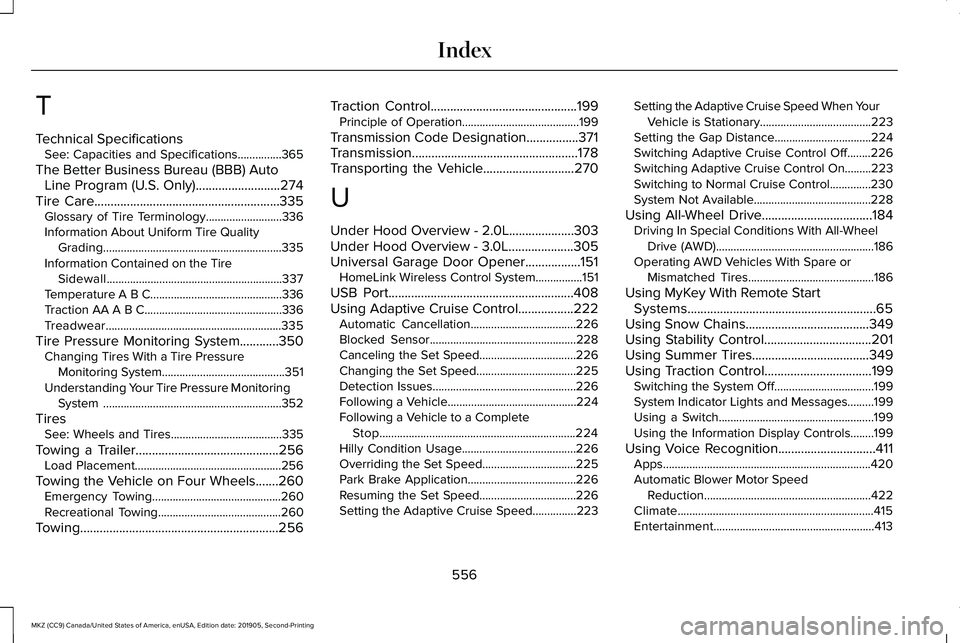
T
Technical Specifications
See: Capacities and Specifications...............365
The Better Business Bureau (BBB) Auto Line Program (U.S. Only)..........................274
Tire Care.........................................................335
Glossary of Tire Terminology..........................336
Information About Uniform Tire Quality
Grading.............................................................335
Information Contained on the Tire Sidewall............................................................337
Temperature A B C.............................................336
Traction AA A B C...............................................336
Treadwear............................................................335
Tire Pressure Monitoring System............350 Changing Tires With a Tire Pressure
Monitoring System..........................................351
Understanding Your Tire Pressure Monitoring System .............................................................352
Tires See: Wheels and Tires......................................335
Towing a Trailer............................................256 Load Placement..................................................256
Towing the Vehicle on Four Wheels
.......260
Emergency Towing............................................260
Recreational Towing..........................................260
Towing.............................................................256 Traction Control
.............................................199
Principle of Operation........................................199
Transmission Code Designation................371
Transmission...................................................178
Transporting the Vehicle
............................270
U
Under Hood Overview - 2.0L....................303
Under Hood Overview - 3.0L....................305
Universal Garage Door Opener
.................151
HomeLink Wireless Control System................151
USB Port
.........................................................408
Using Adaptive Cruise Control.................222 Automatic Cancellation....................................226
Blocked Sensor..................................................228
Canceling the Set Speed.................................226
Changing the Set Speed..................................225
Detection Issues.................................................226
Following a Vehicle............................................224
Following a Vehicle to a Complete
Stop...................................................................224
Hilly Condition Usage.......................................226
Overriding the Set Speed................................225
Park Brake Application.....................................226
Resuming the Set Speed.................................226
Setting the Adaptive Cruise Speed...............
223 Setting the Adaptive Cruise Speed When Your
Vehicle is Stationary......................................223
Setting the Gap Distance.................................
224
Switching Adaptive Cruise Control Off........226
Switching Adaptive Cruise Control On.........
223
Switching to Normal Cruise Control..............230
System Not Available........................................228
Using All-Wheel Drive..................................184 Driving In Special Conditions With All-Wheel
Drive (AWD)......................................................186
Operating AWD Vehicles With Spare or Mismatched Tires...........................................186
Using MyKey With Remote Start Systems..........................................................65
Using Snow Chains
......................................349
Using Stability Control.................................201
Using Summer Tires....................................349
Using Traction Control.................................199 Switching the System Off..................................199
System Indicator Lights and Messages.........199
Using a Switch.....................................................199
Using the Information Display Controls........199
Using Voice Recognition..............................411 Apps.......................................................................420
Automatic Blower Motor Speed
Reduction.........................................................422
Climate...................................................................415
Entertainment.......................................................413
556
MKZ (CC9) Canada/United States of America, enUSA, Edition date: 201905, Second-Printing Index